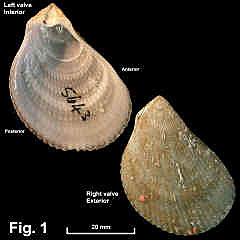|
|
LIMIDAE |
|
|
|
Lima nimbifer Iredale, 1924 Description: Shape variable, oblique tear-drop shaped with well-defined lunule. Dorsal margin short, straight, umbo central and strongly elevated; anterior margin straight with slight byssal gape, ventral and posterior margins uniformly rounded. Hinge line straight, with auricle posteriorly, without teeth, ligament seated in triangular ligament pit above hinge line and semicircular resilifer projecting below hinge line. Interior white, margin crenulated by exterior ribs, muscle scars obscure. Exterior with about 32 longitudinal ribs, not divaricating, smooth in juveniles, with lamellate projections in adults; narrower, smooth interspaces between. Periostracum thin, fawn. Shell colour white, usually discoloured by marine growth. Size: NSW specimens reach up to 50 mm in height. Distribution: Unknown, but see Remarks below. Habitat: Lives attached by a byssus to rocks or corals in the intertidal zone and below. Common. Synonymy: NSW shells have been referred to as either Lima vulgaris (Link, 1807) or Lima lima vulgaris (Link, 1807). Also used has been Lima multicostata G.B. Sowerby II, 1843, but that name is preoccupied and hence not available. Lima tropicalis (Iredale, 1939) was applied to specimens from the Great Barrier Reef, but there is no justification in using that name for NSW specimens, as Huber (2010) does. Remarks: The distribution and name of this species is unclear. The NSW shell is similar to, if not identical with, Lima vulgaris (Link, 1807) which occurs throughout the tropical Indo-West Pacific region, including northern Australia. In general, mollusc species which occur throughout the tropical Indo-West Pacific have a southern limit of northern or central NSW, and sometimes a related species replaces it in temperate southern Australia. It is suggested that in this case a southern species which is indistinguishable in shell form from Lima vulgaris occurs in southern Australia, with a range of NSW to south-western WA. A genetic study is needed to show the truth or otherwise of this hypothesis. If this hypothesis is correct, the name of this southern species would be Lima nimbifer Iredale, 1924 which is based on a specimen from Twofold Bay, NSW. Iredale noted this to be “Common on the littoral of New South Wales”. He went on to name Lima benthonimbifer Iredale, 1925 for specimens from 75-80 fathoms (137-146 m) off Narrabeen, NSW, which show minor differences in shell form to the intertidal species, and so this name is probably a synonym. Fig. 1: Terrigal, NSW (DLB5643) |
|
